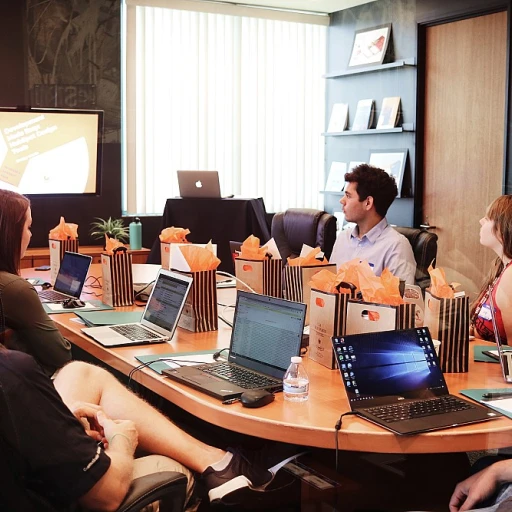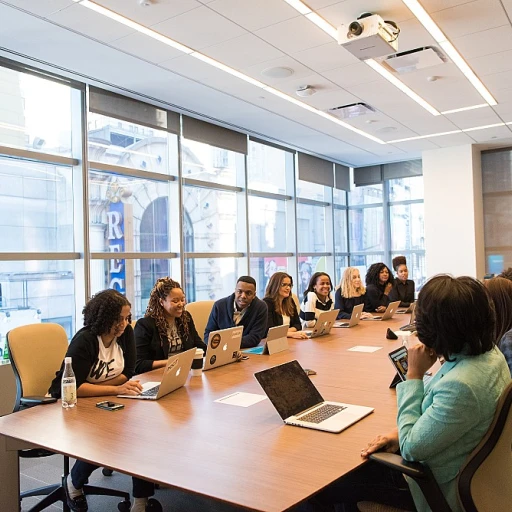
Understanding Career Mobility
Exploring the Dynamics of Transitions
In today's rapidly evolving job market, career mobility has become an essential factor for not only personal growth but also for the overall success of companies. Career mobility refers to the ability of employees to move within and across various roles and departments within an organization or even between different organizations. This movement can occur vertically, through promotions, or horizontally, by taking on new roles that enhance one's skill set.
For employees, career mobility presents opportunities for career advancement and professional growth. It enables individuals to leverage their existing skills while acquiring new ones, thereby increasing their value in the workforce. Internal mobility is a valuable tool that employers can use to retain talented employees, enhance workforce agility, and adapt to changing business needs. Organizations that focus on career development paths often see an increase in employee satisfaction and retention, as these pathways demonstrate a commitment to the professional growth of their staff.
Many companies have embraced mobility programs to facilitate this process. These programs help employees navigate their career paths by offering continuous learning and talent development opportunities. Human resources departments play a key role in structuring these mobility programs to ensure they align with organizational goals and employee aspirations.
In recent years, the focus has shifted towards identifying skills for future growth, emphasizing the importance of reskilling and upskilling within internal talent development strategies. As the job market continues to evolve, employees are encouraged to take part in learning programs that prepare them for new challenges. Professional growth is not only beneficial for the individual but is also integral to enhancing a company’s overall performance.
Exploring different career pathways and mobility careers in today's dynamic job landscape opens up an array of growth opportunities. For those considering a transition into a new field, such as transitioning into a PDHPE teaching career, understanding the nuances of career mobility becomes particularly important. By grasping the concept of career mobility and the opportunities it presents, employees and employers alike can strive for success in both current and future career landscapes.
The Role of Reskilling in Career Advancement
Navigating Skills to Enhance Career Opportunities
In today's rapidly evolving job market, reskilling has become a pivotal component in career development. The modern landscape offers numerous growth opportunities for employees willing to adapt their skillset to align with internal mobility initiatives within organizations. This is not just about acquiring new skills, but rather understanding how these skills can open doors to new career paths and roles.
Reskilling provides employees with the tools necessary to meet the ever-changing demands of their industry. As companies increasingly focus on internal talent and potential career mobility, the ability to adapt and learn becomes even more critical. Employers are now more likely to implement mobility programs and initiatives that foster professional growth and job mobility among their workforce.
Organizations benefit significantly when they help employees grow from within. By investing in continuous learning opportunities, they not only improve employee retention but also enhance their pool of valuable talent. Reskilling programs, such as tuition reimbursement, can be integral in reinforcing this internal development strategy.
The path to achieving career growth is not without its challenges, but a well-rounded reskilling strategy can mitigate these. It creates a structured approach for employees to upgrade their skills and provides a framework for career progression that aligns with both personal aspirations and the organization's objectives.
Explore more about how to successfully transition your career from surviving to thriving through effective reskilling strategies by visiting the following resource.
Identifying Skills for the Future
Mapping Skills That Empower Future Readiness
In a world where career paths are evolving rapidly, understanding which skills will play a crucial role in shaping your future can be the cornerstone of professional growth. As employees pursue career mobility and internal career opportunities, charting a path to acquiring these skills becomes paramount. Companies and organizations are increasingly recognizing the necessity of equipping their workforce with skills that not only address existing roles but anticipate future demands.
Among the driving forces behind this shift is the emphasis on internal talent development. Employers are now prioritizing internal mobility, offering their workforce a chance to explore diverse roles without leaving the organization. This dedication to nurturing internal talent hinges on identifying skills that align with the company’s growth and development trajectory. As a result, employers can create comprehensive mobility programs that empower employees to seize growth opportunities.
However, identifying these skills is not solely the responsibility of the organization. Employees must also be proactive in their pursuit of knowledge and self-improvement. Continuous learning and participation in mobility programs are essential components of charting a successful career pathway. It enables employees to remain agile in the face of industry shifts, accessing rich career development resources that can pave the way for job mobility and professional growth.
Exploring various avenues to acquire future-ready skills can be overwhelming, but leveraging available resources can ease this journey. Enrolling in a strategic career development program or studying emerging trends can help employees pinpoint skill areas that align with long-term career aspirations. Additionally, tapping into resources like tuition reimbursement benefits and human resources-led initiatives can offer substantial support in developing competencies that are in high demand.
Overcoming Challenges in Reskilling
Addressing Barriers in Reskilling Efforts
In navigating the intricate path to career mobility, overcoming challenges in reskilling remains a pivotal task for both employees and organizations. It's no secret that adopting new skills and capabilities is essential for career advancement and internal mobility. However, various obstacles can stand in the way, hindering the journey toward professional growth and job mobility. To begin with, one of the most significant hurdles is the availability of resources. Many organizations strive to offer reskilling programs, but not all employees have equal access to these growth opportunities. Companies must actively support career development by providing access to effective mobility programs or tuition reimbursement, creating a more inclusive environment for learning and development. Moreover, time constraints add another layer of difficulty. Balancing work responsibilities with continuous learning isn't always straightforward. Employers can help employees by integrating reskilling initiatives into employee schedules and encouraging them to participate in these career pathways. Flexibility in program implementation can lead to more successful outcomes, benefiting both the individual and the organization. Another challenge lies in internal talent buy-in. Employees may resist change due to uncertainty about the relevance of new skills to their current roles or future career paths. Human resources and management should communicate the benefits of career mobility programs clearly, emphasizing how new skills can open doors to exciting roles and opportunities for internal career growth. Lastly, cultivating an organizational culture that values talent development is crucial. Companies aiming for sustainable growth should prioritize a culture of learning, encouraging employees to take charge of their professional development. This culture fosters an environment where challenges in reskilling are met with proactive solutions, making it easier for employees to adapt and thrive in evolving job landscapes. In conclusion, vigilance and strategic planning are essential for companies looking to enhance their workforce's agility. By addressing the barriers to reskilling, organizations can pave the way for their employees' career mobility, ensuring long-term success both individually and collectively.Leveraging Online Resources for Reskilling
Harnessing the Resources Available Online
In the modern world of digitalization, the internet is a treasure trove of resources dedicated to reskilling. With a multitude of platforms committed to continuous learning, it’s no wonder more employees are turning to online resources to enhance their skills and boost their career mobility. Today, employers and organizations alike recognize the importance of supporting talent development through structured learning paths. This has led to a surge in opportunities, enabling employees to delve into new roles or refine existing skills.- Online Courses: Various platforms offer specialized courses that help employees develop career-specific skills. These courses are pivotal for career growth, offering a direct pathway to internal mobility within an organization.
- Certification Programs: Structured programs grant recognized certifications, enhancing an employee’s profile and opening doors to new job mobility and career opportunities.
- Webinars and Virtual Workshops: Employers can leverage these for real-time learning experiences. They foster professional growth, providing insights from industry experts and fellow learners.
Success Stories: Real-Life Examples of Career Mobility
Real-world Examples of Successful Career Transition
In today's dynamic job market, numerous professionals have successfully achieved career mobility through strategic reskilling and skill development initiatives. These real-life instances serve as practical insights into the transformative potential of reskilling, as individuals navigate new career paths within their organizations or seek opportunities elsewhere.
One success scenario that stands out is how companies are harnessing internal talent to fill high-demand roles. By implementing robust internal mobility programs, organizations are investing in their existing employees' growth, thus fostering an ecosystem of continuous learning. For example, human resources departments are creating tailored career development pathways, allowing employees to explore different roles and broaden their skill sets without leaving the company.
Additionally, many employers are extending programs like tuition reimbursement as a way to support continuous professional growth. This empowers employees to take on new challenges and responsibilities by funding their pursuit of additional education and certifications, which are crucial in adapting to rapidly changing market needs.
Furthermore, employees themselves are taking charge of their career growth by proactively identifying skills of the future. They are leveraging resources from online platforms and internal company training programs. This proactive approach helps them pivot to new roles, resulting in enhanced job mobility and career advancement.
Organizations benefit significantly from these investments in internal talent development. They retain experienced employees while minimizing recruitment costs and enhancing talent retention. For the employees, this leads to a satisfying professional journey characterized by new growth opportunities and improved career mobility.
The stories of these transformative journeys highlight the tangible impact of reskilling on career paths. They illustrate a partnership between organizations and employees geared towards mutual benefits, which ultimately drives both parties towards success in an increasingly competitive environment.













